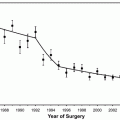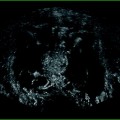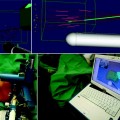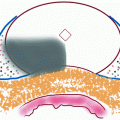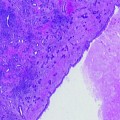Study
PSA (ng/ml)
GS
cT
bx criteria
Bahn et al.22a
All
(mean = 4.9)
5–7
N/A
Initial 6–8 cores, then targeted bx including NVB and SV if ECE was suspected
Ellis et al. [23]
All
(mean = 7.2)
3–10
(mean = 6)
T1c–T2c
Unknown (retrospective study)
Onik et al. [17]
0.9–18
3–8
T1c–T2b
Second bx on negative side, TRUS
Lambert et al. [24]
1–13.1
≤6, 3+4
T1c
Could have 1 or 2 contiguous cores and a tumor volume <10% in 12 core bx
Truesdale et al. [25].
Task Force Selection criteria (please see Table 18.2)
Ahmed et al. [26]
<15
≤4+3
≤cT2b
Multiparametric MRI suggested transperineal mapping biopsy to confirm unilateral disease
Ultimately, due to the complexity of early carcinogenesis, trying to identify appropriate candidates at the initial stage of disease for FT encompasses a different clinical evaluation and criteria set that stands apart from the selection criteria utilized for conventional whole gland selection criteria. Several investigators have used the D’Amico definition to select appropriate candidates for FT among low-risk candidates [29]. For example, in a clinical study of 538 patients with low-moderate risk features treated with radical prostatectomy, Polascik et al. found that only two pretreatment clinical variables were significantly predictive of pathologic unilateral PCa: negative family history of PCa and clinical unilaterality based on prostate biopsy [30]. The strongest predictor in multivariate analysis of pathologic unilaterality was biopsy unilaterality. These variables can be used to assess men with low to low-moderate PCa prior to selection of subtotal ablation along with other established low-risk features of PCa. At present, it does not appear that any prostate-specific antigen (PSA) threshold, biopsy Gleason grade, or clinical stage cut point within the low-risk category can better select men with unilateral or unifocal disease.
However, at present there is neither a consensus as to a strict definition of inclusion/exclusion criteria nor pretreatment planning guidance for focal therapy. For instance, Yoon et al. analyzing pathological features of 100 RP specimens of low-risk patients with clinically unilateral disease by prostate biopsy demonstrated that none of the 20 cases with contralateral adverse pathology had PSA values >10 ng/ml. In contrast, of the seven cases with serum PSA >10 ng/ml, five had no contralateral tumor, and the remaining two had a contralateral organ confined lesion [8]. Whether this finding implies that the baseline PSA level needs to be <10 ng/ml to consider focal therapy remains unclear and needs further study. Recently Sartor et al. on behalf of the Task Force Selection Criteria panel summarized the proposed relative inclusion criteria for patients considering FT (Table 18.2) [31], which also have been developed on an empiric basis and need further scientific confirmation in randomized clinical trials.
Table 18.2
Proposed Task Force selection criteria for patients considering focal therapy
Method | Criteria |
|---|---|
Clinical | PSA <10 ng/mL and PSAD <0.15 ng/mL/g |
Biopsy Gleason score 3+3 or less (no grade 4 or 5) | |
Clinical stage T1NxMx or T2aNxMx | |
Biopsy | Either transperineal mapping biopsy or, if transrectal, number of cores adjusted to volume of prostate: 10 cores minimum + 2 cores for every 10 g of prostate >40 g, to maximum of 18 cores |
No more than two adjacent sectorsa positive for cancer | |
Cancer volume in biopsy cores: total length of cancer <10 mm total and <7 mm in any 1 core; less than one-third of cores positive for cancer | |
Imaging (MRI with or without MRSI) | Single, biopsy-proven lesion on imaging |
Largest dimension <15 mm if prostate volume >25 g, or <10 mm if volume <25 g | |
Capsular contact <5 mm on axial image | |
No definite evidence of extracapsular extension or seminal vesicle invasion |
A consensus panel of the “Second Symposium on Focal Therapy and Imaging in Prostate and Kidney Cancer” hosted in Amsterdam, June 10–13, 2009, recommended the following criteria for patient selection (Table 18.3) [32]. Candidates for focal treatment should have unilateral low- to intermediate-risk disease with clinical stage ≤cT2a. Prostate size and both tumor volume and tumor topography are important case selection criteria that depend on the ablative technology used. Currently, the best method to ascertain the key characteristics for men who are considering focal therapy is the exposure to transperineal template mapping biopsies. MRI of the prostate using novel techniques such as dynamic contrast enhancement and diffusion-weighed imaging are increasingly being used to diagnose and stage primary prostate cancer with excellent results. For general use, however, these new techniques require validation in prospective clinical trials. Until such things are performed, MRI will, in most centers, continue to be an investigative tool in assessing eligibility of patients for focal therapy [32].
Table 18.3
Candidate selection for focal therapy
1.Candidates for FT should ideally undergo transperineal template mapping biopsies, although a state-of-the art multifunctional MRI with TRUS biopsy at expert center may be acceptable |
2.Candidates for FT should have a life expectancy of 10 or more years |
3.Patients with previous prostate surgery should be counseled with caution |
4.Patients with previous radiotherapy to the prostate or pelvis should not be treated until more data are available, although the panel accepted that focal salvage therapy may be a possibility in the future |
5.The effects of FT on men with lower urinary tract symptoms are not well known. These men should be counseled with caution |
6.There will be specific attributes that are more related to the energy source than to FT in general. Issues such a prostatic size, presence of prostatic calcification, cysts, TUR cavity, access to rectum, and concurrent inflammation of rectal mucosa may need to be taken into consideration when selecting the optimal therapy |
7.FT should be limited to patients of low to moderate risk |
8.FT should be limited to men with clinical T2a or less N0M0 disease |
9.FT should be limited to men with radiologic ≤T2b N0M0 disease |
10.Defining the topography of the cancer is important. Disease that is predominantly apical or anterior in disposition may be technically difficult to manage with existing treatment modalities |
11.The long-term effects of FT on potency/erectile dysfunctions are not known. Men should be counseled in this regard before therapy |
Limitations of Conventional Sextant, Extended, and Saturation Biopsy for Patient Selection
In the absence of an accurate imaging modality for PCa detection, the prostate biopsy remains as the single crucial factor for treatment planning, especially when considering focal therapy. The spectrum of prostate biopsy cores ranges from 6 to 80, yet it is not known how many cores are sufficient to assure that a clinically significant cancer will not be missed on the untreated side.
It should be remembered that most of the literature analyzing various biopsy schemes are aimed at the detection of PCa without regard to laterality or focality as this detailed information is not necessary for whole gland therapy. Similarly, a retrospective analysis of various biopsy techniques performed simply to diagnose and not map PCa foci will have limited applicability for focal therapy planning.
A series of studies demonstrated the low diagnostic yield of routine sextant and extended prostate biopsy to predict unilateral disease [33–35]. Even a single positive core identified in low-risk PCa may not exclude bilateral disease in all instances. Barber et al. investigated the data of 129 men with a single positive PCa core (in a 6–12 core biopsy), with 46 (36%) patients subsequently treated with RP [36]. Final pathological assessment showed that almost 90% with GS ≤6 have disease contralateral to the positive biopsy core and approximately one-fourth (22%) having a component of high-grade disease in the contralateral lobe. The single positive core correctly predicted the laterality of the largest tumor focus in 71% of cases [36]. Emerging data suggest that the traditional sextant or extended 12-core biopsy is likely not sufficient to exclude contralateral disease despite a single or unilateral focus identified by biopsy [35].
Further Patel et al. [37] and Jones [38] moved towards a 20-core template for saturation biopsy using the transrectal approach to show that sampling from the medial sector (mid-gland and base) did not add value in the standard 24-core saturation biopsy. Recently, the same group from the Cleveland Clinic showed that most (90%) patients with unilateral PCa on saturation biopsy had bilateral cancer in the radical prostatectomy specimen (in 72 patients) with 31% of those being clinically significant tumors [39]. They concluded that a negative saturation biopsy could not be used as a single determinant in the selection of candidates for focal therapy.
The Directive to Improve Patient Selection for FT
TRUS-Guided Prostate Mapping Biopsy Is a Viable Approach
At present, we still lack an ideal means to accurately and reliably image prostate cancer, although several investigators believe that some techniques have promise to detect the index lesion as the main target for FT. Clearly, investigators and industry recognize the need to develop such technologies and doubtless new discoveries will be made. However, at present, transperineal three-dimensional prostate mapping biopsy (3D-PMB) has a potential to provide detailed cancer location and grade information that can be utilized to select appropriate patients for focal therapy or active surveillance regimens. Onik et al. tested a new staging 3D-PMB in 185 patients with unilateral cancer on TRUS biopsy [40]. Biopsies were taken every 5 mm throughout the volume of the prostate with a mean of 52.2 cores (SD ± 20.61). In 110 patients (61.6%), cores were positive for cancer bilaterally, and 41 patients (22.7%) had upgrading to Gleason score 7 and higher. Thirty-six patients had negative results on 3D-PMB producing a false-negative rate of 20%. A total of 35 of these patients had a cancer volume <5 mm in greatest dimension [40]. Barqawi et al. performed 3-D PMB on 180 consecutive men who were interested in active surveillance or FT and had previously undergone a TRUS-guided biopsy having low stage disease or being negative for cancer [41]. The median number of cores obtained by TRUS and 3D-PMB was 12 and 56, and the median number of positive cores was 1 and 2, respectively. The authors found Gleason score upgrading in 49 of 180 cases (27.2%) and upstaging in 82 (45.6%) on subsequent follow-up biopsy. Ultimately, these data highlight some limitations of 3D-PMB that warrant further evaluation.
Magnetic Resonance Image (MRI)-Guided Prostate Biopsy
Hambrock et al. investigated the tumor detection rate of regions suspicious for PCa under multiparametric 3 T MRI-guidance that were subsequently biopsied in 68 men previously having repeated negative TRUS-guided prostate biopsies [42]. The clinical significance of tumors detected was based upon established criteria, including prostate-specific antigen, Gleason grade, stage, and tumor volume. The tumor detection rate using multimodal 3 T MRI-guided biopsy was 59% (40 of 68 cases) using a median of 4 cores that was significantly higher than that of TRUS-guided prostate biopsy in almost all patient subgroups. The detection rate of tumor suspicious regions was high (70 of 71 patients) which may be explained by the use of multimodal MRI rather than conventional T2-weighted (T2W) MRI [42]. However, high cost of this procedure coupled with limited access to MRI for most urologists significantly limits its feasibility.
Stay updated, free articles. Join our Telegram channel

Full access? Get Clinical Tree



